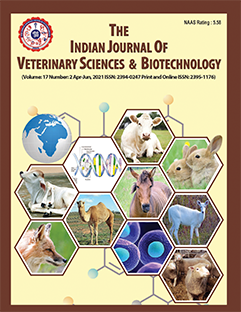Effect of Incorporation of De-Oiled Distillers Dried Grain with Solubles in the Concentrate Mixture on Growth Performance of Murrah Buffalo Calves
DOI:
https://doi.org/10.48165/ijvsbt.21.4.30Keywords:
Buffalo calves, Cost economics, Cottonseed cake, De-oiled DDGS, Digestibility, GrowthAbstract
This experiment was aimed to assess the impact of inclusion of de-oiled DDGS (dDDGS) as source of protein to replace cotton seed cake protein (CSC) in the concentrate mixture on growth, nutrient digestibility and cost economics. In a 90 days growth trial, 18 buffalo calves in the age range of 6-9 months old and 79-84 kg BW were randomly divided into three groups and allotted to one of the dietary treatments. In the experimental feeds CSC (on CP basis) was substituted with de-oiled DDGS at 0% (T1), 50% (T2) and 100% (T3) levels. The findings suggested that BW, ADG and FCR had significantly (p<0.01) increased in the T3 group compared to control group. Digestibilities of DM, CP, CF (p<0.01), OM and cellulose (p<0.05) were significantly increased in T3 group. The cost of feed/kg BW gain decreased by Rs. 35 in T3 and Rs. 15 in T2 group when compared to control group. DCP and TDN contents expressed either as intake (kg/d) or as % in diet consumed increased significantly (p<0.01). The DCP intake expressed as g/kg W0.75 was significantly (p<0.01) improved in T3 group. The DM, DCP and TDN intakes expressed as g/kg W0.75 and ME intake (M cal/kg W0.75) were similar among the treatments. It is concluded that de-oiled DDGS is an alternative to CSC for reduction of cost/kg live weight gain.
Downloads
References
1. Ale, K.B., Scott, J., Okere, C., Abrahamsen, F.W., Gurung, R., & Gurung, N.K. (2022). Effects of low-fat distillers dried grains with solubles supplementation on growth performance, rumen fermentation, blood metabolites, and carcass characteristics of Kiko crossbred wether goats. Animals, 12(23), 3318.
2. AOAC. (2007). Official Methods of Analysis (18th ed.). Association of Official Analytical Chemists, Washington DC: AOAC International.
3. Dey, D., Sharma, B., Mohammad, A., Mandal, D.K., Bhakat, C., & Dutta, T.K. (2019). Effect of feeding rice distillers dried grain with solubles as major protein source on nutrient digestibility and growth performance of Jersey crossbred calves. Indian Journal of Animal Research, 54(4), 446–451.
4. Etman, K., Zeid, A., & El-Monayer. (2010). Utilization from new nutritional resources in ruminant feeding: 1- Effect of using dried distillers’ grains with solubles (DDGS) in rations for fattening Friesian calves. Journal of Animal and Poultry Production, 1(12), 659–668.
5. ICAR. (2013). Nutrient Requirements of Cattle and Buffalo. Indian Council of Agricultural Research, New Delhi, India.
6. Fonseca, N.V.B., Cardoso, A.S., Hoffmann, A., Leite, R.G., Ferrari, A.C., Fernandes, M.H.M.R., & Reis, R.A. (2021). Characterization and effects of DDG on the intake and digestibility of finishing bulls in feedlots. Acta Scientiarum Animal Sciences, 43, e51877.
7. Obeidat, B.S. (2018). Influence of corn-dried distiller’s grain with solubles on growth performance and blood metabolites of Awassi lambs offered a concentrate diet. Italian Journal of Animal Science, 17(3), 636–642.
8. Omer, H.A.A., Abdel-Magid, S., El-Nomeary, Y.A.A., Nassar, S.A., Nasr, S.M., & Abou-Zeina, H.A.A. (2015). Nutritional impact of partial replacement of cotton seed meal with distillers dried grain with solubles (DDGS) on animal performance, digestion coefficients and some blood constituents in crossbred calves. World Applied Sciences Journal, 33(4), 580–589.
9. Reddy, P., Lakshmi, R., Raju, J., Kishore, K., & Kumar, C. (2017). CNCPS fractionations and in-vitro nutrient digestibility of corn dried distiller grains with solubles from various ethanol plants in Andhra Pradesh. International Journal of Livestock Research, 7(2), 164–171.
10. Sihag, S., Sihag, Z.S., Shunthwas, I.J., & Kumar, S. (2017). Efficacy of dried distillers’ grains with solubles as a replacement for soybean meal in the rations of growing goats. Indian Journal of Animal Nutrition, 34(4), 408–413.
11. Singh, S., Thakur, S., Yogi, R., & Ud-Deen, A. (2018). Effect of replacing oil seed cakes with rice dried distillers grains with solubles in concentrate mixture on growth and nutrient utilization in Murrah heifers. Indian Journal of Animal Nutrition, 35(2), 144–148.
12. Snedecor, G.W., & Cochran, W.G. (1994). Statistical Methods (11th ed.). The Iowa State University Press, Ames, Iowa, USA, p. 267.
13. SPSS. (2019). Statistical Packages for Social Sciences (Version 26.0). SPSS Inc., Chicago, IL, USA.
14. Tomaz, L.A., Niehues, M.B., Baldassini, W.A., Castagnino, P., Bertoco, J.P.A., Cleef, E., & Neto, O.R.M. (2021). Increasing levels of de-oiled wet distillers grains in feedlot diets on nutrient digestibility, ruminal fermentation and microbiology. Livestock Science, 245, 104415.
15. Van Soest, P.J., Robertson, J.B., & Lewis, B.A. (1991). Methods for dietary fibre, neutral detergent fibre and non-starch polysaccharides in relation to animal nutrition. Journal of Dairy Science, 74, 3583–3597.
Downloads
Published
Issue
Section
License
Copyright (c) 2025 Indian Journal of Veterinary Sciences and Biotechnology

This work is licensed under a Creative Commons Attribution-NonCommercial-NoDerivatives 4.0 International License.




